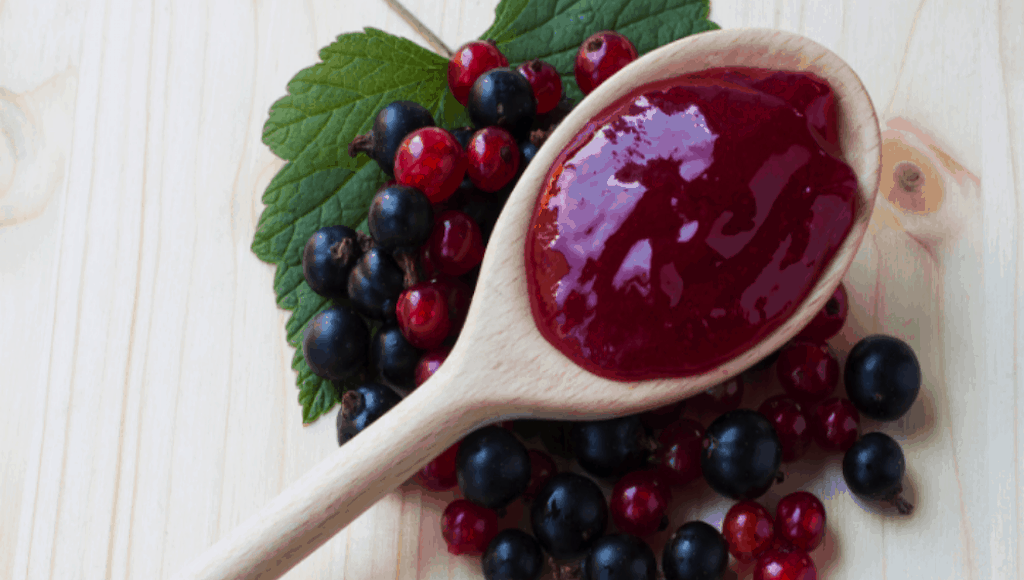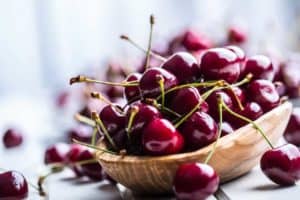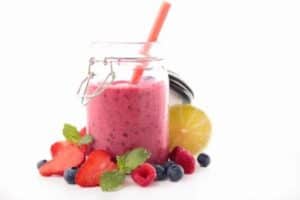How Is Grape Jelly Made?
All jellies and jams are made by combining fruit or fruit juice with sugar and heating it to a high temperature. Technically, jelly is made with only fruit juice, whereas jam contains fruit pulp and maybe skin and, in the case of some berries, the seeds. Generally, we refer to all jams and jellies as simply “jelly” to keep it simple.
People have been making jelly since at least the time of the crusades. It was an easy way to make the fruit last much longer than its naturally short shelf-life. Small batches would have been made in home kitchens, the same way they still are today for many home-chefs.
Commercially, jelly can be made in much larger volumes. They also tend to use high fructose corn syrup rather than granulated sugar. This is due to soaring sugar prices, which make mass production very expensive. Also, granulated sugar can crystalize when cooked in large batches to high temperatures.
The fruit is heated in large kettles or vats with the sugar or syrup, and additives such as pectin and citric acid are added to ensure the mix will set and have the right balance of sweetness and sharpness. Flavorings can also be added to make the jelly unique.
Organic Grape Jelly vs. Non-Organic
Flavor-wise, you shouldn’t notice too much difference between organic and non-organic grape jelly. Organic refers to how the grapes are grown. Organic means:
- No chemical pesticides
- No chemical herbicides (weed killers)
Many people are reassured by knowing that no chemicals were used to grow the grapes used to make their favorite jelly. However, it’s also worth noting that non-organic grapes are deemed perfectly safe and that the amount of any chemical used that ends up on the fruit is considered to be negligible. Plus, the fruit is well washed before the jelly making process.
Other Variations of Grape Jelly
Welch’s is famous for their Concord grape jelly. The Concord grape was used by Dr. Thomas Branwell Welch to launch the now famous grape juice business in 1869. Today, it’s considered the most popular grape jelly in America and available in squeezy bottles as well as traditional jars.
The Valiant grape is also used for making grape jelly. The vine itself is hardy and copes well with cooler temperature, and the sweet, blue grapes make for a delicious jelly.
White grapes can be used for jelly too. A popular choice is the Edelweiss grape. It ripens a little earlier than some other grapes but doesn’t cope too well with the cold.
Low sugar jelly is available for those that want to reduce their sugar intake, or who need to avoid blood sugar level spikes for health reasons. Artificial sweeteners are usually used, and there may also be gelatin added to help with the “set” so do check the ingredients. Jams with gelatin will not be suitable for vegans.
How to Make Grape Jelly at Home
If you’re wondering how to make grape jelly for yourself, there are two ways to go about doing this:
- Use lots and lots of fresh grapes
- Use store-bought grape juice
The second option is generally considered simpler. Fresh grapes have to be plucked from their stalks, washed and crushed. This is a fun process, but if you’re short on time, the juice is the way to go.
Whichever option you go for, you’ll also need plenty of sugar and some pectin. Pectin is a naturally occurring fiber found in plenty of fruits, most notably apples, lemons, and blackberries. What does pectin do? Pectin is the substance that helps the jelly set, so it’s not all runny when you open your jar.
Grapes are naturally low in pectin, which is why you need to add pectin as a separate ingredient. Crushed grapes or juice are heated with sugar and water until all the sugar has dissolved. For a smooth jelly, the mixture can be sieved to take out the pulp ad skin of the grapes. This step isn’t necessary if using a grape jelly recipe with juice.
Once the sugar has dissolved, and any straining/sieving has taken place, the pectin is added and dissolved. Then it’s time to turn the heat up! Jelly sets at a temperature of about 220F. You can even purchase a cooking thermometer with a “Jelly” mark on it to help you get the right “set” for your homemade grape jelly.
Grape jelly is usually stored in sterile jars. Home-chefs can sterilize their jars in an oven, a microwave, with boiling water or with a home sterilization chemical.
Health Benefits of Grape Jelly
It’s worth remembering that grape jelly is very high in sugar. Jelly is considered a preserve, meaning it will last for a long while in the cupboard or refrigerator. It’s the high sugar content that preserves the jelly and helps keep it fresh. But, as long as you’re not eating it by the spoonful straight out of the jar, you shouldn’t be ramping up your sugar intake too much.
Here are some of the health benefits of grape jelly:
- Grapes are low in calories
- Most of the calories comes from sugar, so pairing grape jelly with protein or fat is ideal
- Grapes have zero cholesterol
- Grapes are high in manganese, good for healthy bones and your metabolism
- Grapes contain plenty of potassium,
- Grapes also contain copper, essential for healthy joints and a good immune system
- Grapes are high in many essential vitamins includingvitamins C and K
- Certain types of grapes, like the Concord grape, may be good for cardiovascular health
Are PB&J Sandwiches Good for You?
It’s a national favorite. Peanut butter jelly is one of America’s favorite combos. The country is almost evenly split over creamy or crunchy (52 percent prefer creamy). The same holds for strawberry vs. grape jelly. But are PB&J sandwiches actually good for you? Here are the facts:
- Peanuts are high in protein
- Peanuts are also high in beneficial fats
- Peanuts contain a huge range of vitamins and minerals including vitamins E and B6
- Peanuts are high in dietary fiber
- Because peanuts are high in fat and protein, they help balance out the sugar content of the grape jelly, making a PB&J a surprisingly balanced treat
Peanut butter is sometimes a little high in salt content. An excellent way to avoid too much salt intake is to have a go at making your own peanut butter. Roasting and blending your own peanuts allows you to control exactly the amount of salt that goes into your peanut butter. You can also make it as creamy or crunchy as you like.
Peanut butter may also contain palm oil, which can be bad for the environment when not ethically and sustainably sourced — yet another excellent reason for making your own peanut butter at home.
PB&Js are so popular with kids because they are a high energy snack. Active kids will burn this energy off in no time, plus the protein helps with their growth. For adults, it’s worth thinking about how to make a healthier PB&J. Use whole-wheat bread, spread your jelly thinly, and don’t indulge too often if you aren’t planning on some physical activity.
Healthier Grape Jelly Alternatives
Is there any real alternative to the classic flavor of grape jelly? We think not. However, if all that sugar is putting you off, here are some other options you could try:
- No-added sugar grape jelly, but check the ingredients for what other additives there are
- Pureed fruit- blitz some fresh berries in a blender and spread it straight on the bread
- Canned fruit is often soft enough to spread and may have less sugar
- Combine honey and fruit for a naturally fruity and sweet hit
If you want to stick to the jelly, that’s fine. As we have seen, grapes have plenty of health benefits. Just remember to balance your sugary treat with sensible fats or protein to keep your blood sugar level, and you can keep grape jelly a part of your everyday diet.





